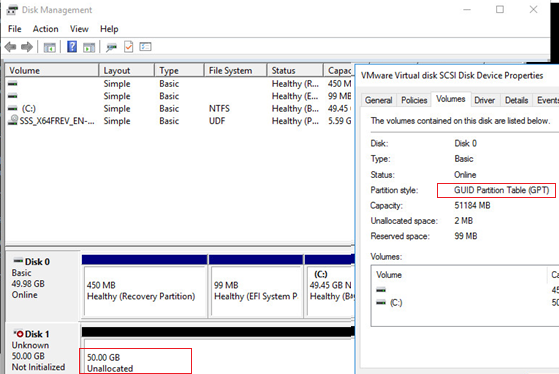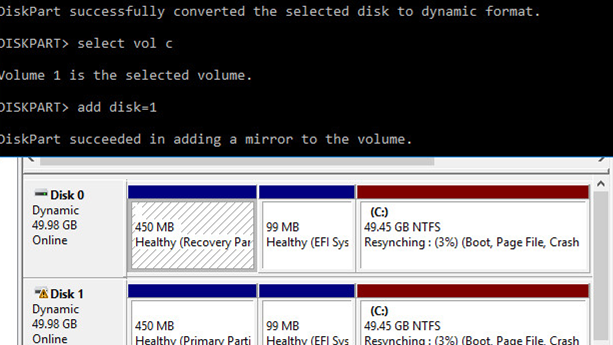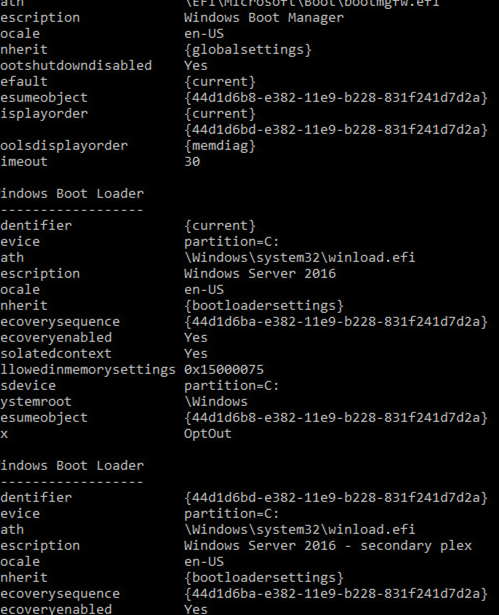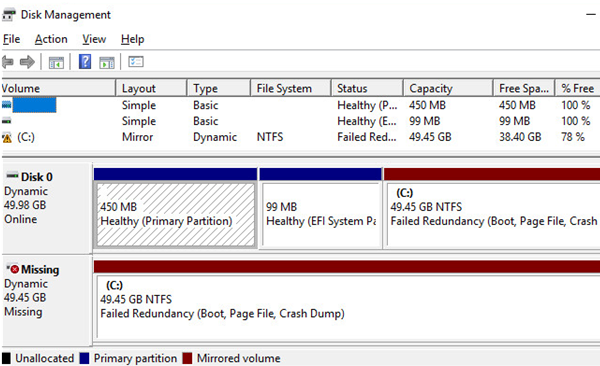How To Install Windows 10 On A Second Hard Drive
In this article we'll show y'all how to create a software mirror (RAID1) from two GPT disks with Windows Server 2022/Windows 10 installed for UEFI. We'll consider a full-featured BCD bootloader configuration that provides correct Windows boot and protects your Os and data in example of whatever drive failure.
So, I take a unproblematic computer with an UEFI architecture and two identical 50GB disks, but without congenital-in RAID controller. Our task is to install an Bone (Windows Server 2022, Windows 10 or a free Hyper-V server) on the first GPT disk and and so create a software mirror (RAID1) from two disks.
In most cases, if you cull between software and hardware RAID, you lot'd ameliorate select the latter. Motherboards with an integrated physical RAID controller are available fifty-fifty for home users today.
Write an installation Windows ISO epitome on a DVD/USB stick, boot your reckoner from this device (in the UEFI way, not the Legacy i) and run the installation of Windows Server 2022.
After the installation is complete, open Deejay Management snap-in (diskmgmt.msc) to brand sure that the first disk is using GPT (Disk Properties -> Volumes -> Partition mode –> GUID sectionalization tabular array), and the 2nd one is empty (unallocated).
Contents:
- Preparing GPT Partition Table for a Mirror on Disk 2
- How to Convert Disks to Dynamic & Create a Mirrored Deejay?
- How to Create GPT Mirror for EFI Segmentation?
- How to Copy EFI partition and BCD Store to a 2d Drive?
Preparing GPT Partition Table for a Mirror on Deejay 2

Run the control prompt with the administrator privileges and run diskpart. Enter:
DISKPART>List disk
As you can run across, there are 2 local disks bachelor in the system:
-
Deejay 0– a disk with GPT, Windows is installed on -
Deejay 1– an empty unallocated disk

Clean the second disk again merely in example and convert it into GPT:
Select disk one
clean
Convert GPT
Display the list of partitions on the 2d disk:
List role
If in that location is at least 1 partition on the Deejay 2 (in my example information technology is Partition 1, with the Reserved label and Size 128 Mb), delete information technology:
Sel function i
Delete partition override

Display the list of partitions on starting time disk (disk 0). Then you volition have to create the aforementioned partitions on Disk i.
Select disk 0
List part
There are 4 partitions:
- Recovery – 450MB, a recovery partition with WinRE
- System – 99MB, an EFI partition (more than well-nigh the partition structure on GPT disks)
- Reserved – 16MB, an MSR sectionalisation
- Primary – 49GB, a main segmentation with Windows prototype

Create the aforementioned partitions construction on Deejay 1:
Select disk one
Create partition chief size=450
format quick fs=ntfs label="WinRE"
fix id="de94bba4-06d1-4d40-a16a-bfd50179d6ac"
create division efi size=99
create segmentation msr size=xvi
list part

How to Convert Disks to Dynamic & Create a Mirrored Disk?
Then catechumen both disks to dynamic:
Select disk 0
Catechumen dynamic
Select disk 1
Con dyn

Create a mirror for a arrangement drive (drive letter C:). Select a sectionalisation on Disk 0 and create a mirror for it on Disk i:
Select volume c
Add together deejay=one
The following message will appear:
DiskPart succeeded in adding a mirror to the volume
Open up Deejay Management and make sure that bulldoze C: synchronization has been started (Resynching). Await till it is over, it may take upwards to several hours depending on the size of the C: partition.

When booting Windows, the Windows Boot Director bill of fare will appear where you tin select what disk to boot from. If you practice non select a disk manually, the organisation will endeavor to boot from the commencement i in xxx seconds:
- Windows Server 2022
- Windows Server 2022 – secondary plex

However, the problem is that the bootloader configuration is stored only on the kickoff drive, and if you lose information technology you won't be able to boot Windows from the second drive without additional deportment. In fact, you have protected your data (only not the Windows bootloader) from a failure of the 2d deejay only.
A software Windows RAID cannot be used to create a fully functional EFI sectionalisation mirror. Since the Bone boot files are located on the EFI segmentation, if the first disk fails, y'all won't exist able to boot from the 2d disk without the manual repairing of your EFI bootloader. Information technology is quite difficult for a beginner and takes some fourth dimension (you may not have it if in that location is a oversupply of angry users around).
At present we'll show you how to copy the EFI sectionalisation to the second disk and change the BCD bootloader configuration to enable booting Windows from both the start and second drives.
How to Create GPT Mirror for EFI Segmentation?
And then you lot have to prepare the EFI partition on the second disk in the mirror in society your computer can utilize this partitioning to boot Windows. Assign the bulldoze letter S: to the EFI partition on Disk 1 and format it in FAT32:
Select disk 1
Select role ii
assign letter of the alphabet=S
format fs=FAT32 quick

Then assign the letter P: to the EFI partition on Deejay 0:
select disk 0
select partitioning 2
assign letter=P
get out
How to Copy EFI partitioning and BCD Store to a Second Drive?
Brandish the current BCD bootloader configuration using the following control:
bcdedit /enum
When creating a mirror, VDS service has automatically added the BCD entry for the 2d mirror deejay (labeled "Windows Server 2022 – secondary plex").

In gild to permit booting from EFI sectionalization on the 2d disk if first disk failure, you must change your BCD configuration.
To practise it, re-create the current Windows Boot Manager configuration:
bcdedit /re-create {bootmgr} /d "Windows Kick Manager Cloned"
The entry was successfully copied to {44d1d6bf-xxxxxxxxxxxxxxxx} And so copy the configuration ID and utilize it in the post-obit command:
bcdedit /set {44d1d6bf-xxxxxxxxxxxxxxxx} device partition=south:
If you have washed information technology correctly, this message will announced:
The operation completed successfully.

List the current Windows Boot Manager (bcdedit /enum) configuration. Annotation that the bootloader is now having two options for boot from EFI partitions on different disks (default and resume object).

And then you must copy your BCD shop from the EFI partition on Disk 0 to Disk 1:
P:
bcdedit /export P:\EFI\Microsoft\Boot\BCD2
robocopy p:\ south:\ /eastward /r:0

Rename the BCD shop on Deejay 1:
Rename s:\EFI\Microsoft\Kicking\BCD2 BCD
And delete the copy on Disk 0:
Del P:\EFI\Microsoft\Kicking\BCD2

If your showtime deejay fails, you need to select the "Windows Boot Managing director Cloned" item in the Windows Boot Manager (boot menu) and then "Microsoft Windows Server 2022 — secondary plex" in order to boot your Windows correctly.
If 1 of the disks fails, you will get the Failed Redundancy message in Disk Management snap in.

In this case, yous volition have to supplant the failed disk, delete the mirror configuration and create a software RAID i from the beginning.
Source: http://woshub.com/software-boot-mirror-gpt-windows/
Posted by: mezathonegive.blogspot.com


0 Response to "How To Install Windows 10 On A Second Hard Drive"
Post a Comment